Introduction of Boba
Boba Network is an Ethereum Layer 2 Solution that is designed to drastically improve the speed and efficiency of ethereum. Boba uses Optimistic Rollup technology that combines outstanding open-source work with the research and development of swaps based on onramps, rapid exits, and cross-chain bridging. Boba was created because it is essentially a modified version of Ethereum, making it relatively easy to ensure Ethereum Virtual Machine (EVM) and Solidity compatibility in minimizing the efforts required to migrate smart contracts from Layer 1 (L1) to Layer 2 (L2).
What is BOBA’s vision?
BOBA’s vision is to gain more accessibility to the market with a larger audience by providing a more cost-effective, fast migrating process and more capacity by delivering more layers to the user. Hence, BOBA takes the benefit of Ethereum by using it as an active transaction and settlement layer to encourage more transactions in BOBA. Plus, by using Ethereum as the settlement layer will make the transactions in BOBA much faster and cheaper.
Therefore, together with other developers such as oolong swap, senpai swap, and others, BOBA has provided more exciting opportunities for the users to farm and trade Non-fungible tokens (NFTs).
How to bridge to Boba on the Network?
Currently, the developer is working on user experience to a point where they even subsidise some of the costs for bridging to Boba to reduce a couple of clicks in the process.
This is how to bridge to Boba using $OMG
- Ensure that you holding $OMG in your own private wallet, not an exchange wallet and connect your wallet to Metamask. (https://metamask.io)
- Go to boba.gateway.network to connect to Boba Network using your Metamask

- Scroll down to where it shows OMG and click Bridge
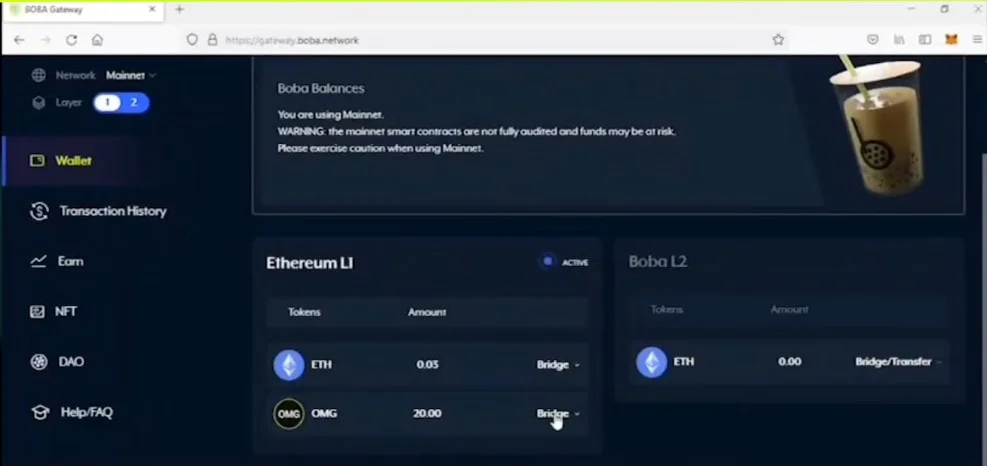
- Select “Fast Bridge to L2”
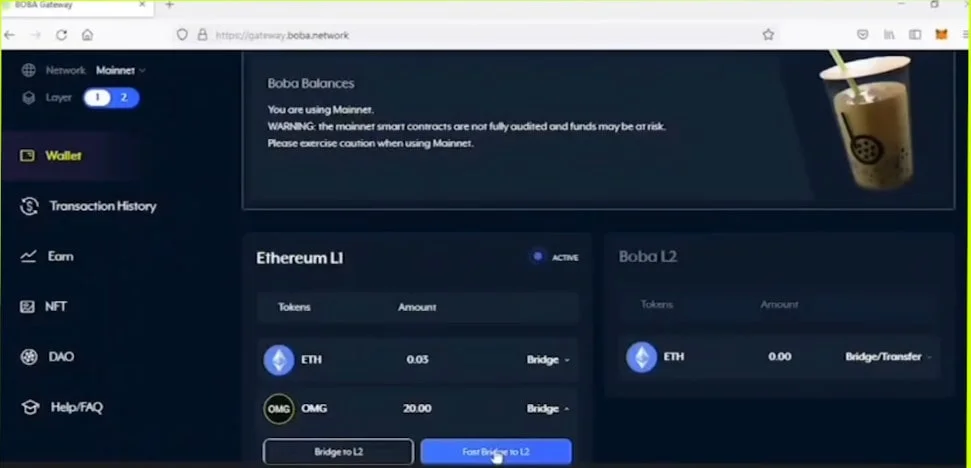
- Enter the amount of OMG you like to bridge. Choose “Use all” to bridge them all. Then click the “Bridge”button.
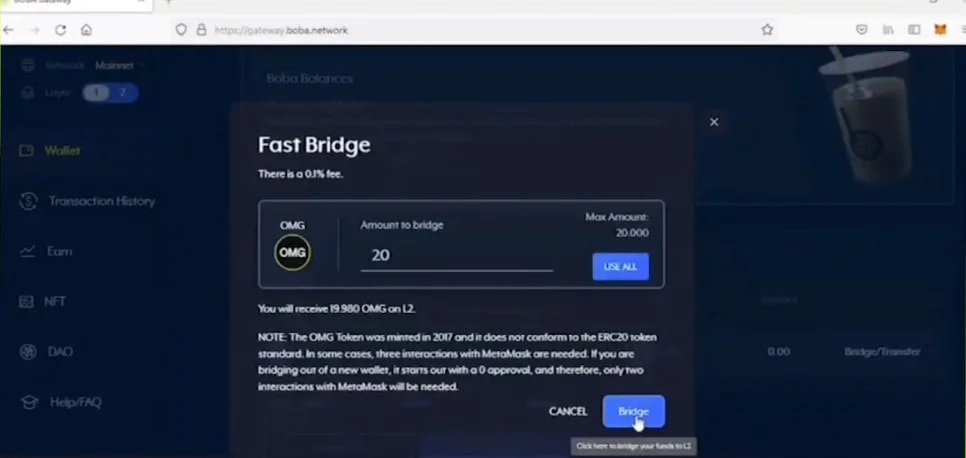
- Metamask will pop up. Confirm the transaction by clicking “Confirm”. First check you happy with the gas fee, which is paid with Ethereum.
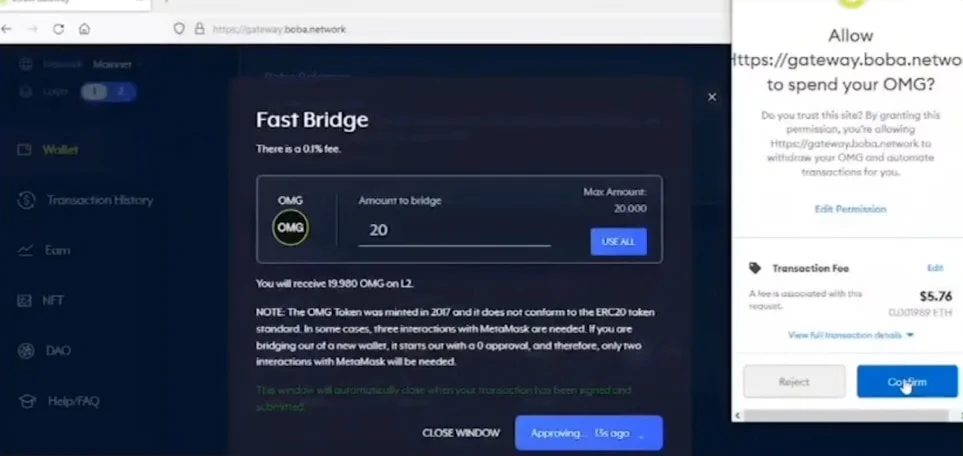
- Once the transaction is confirm, the Metamask will show confirmation of the first transaction and pop up again for the second transaction confirmation. Click “Confirm”.
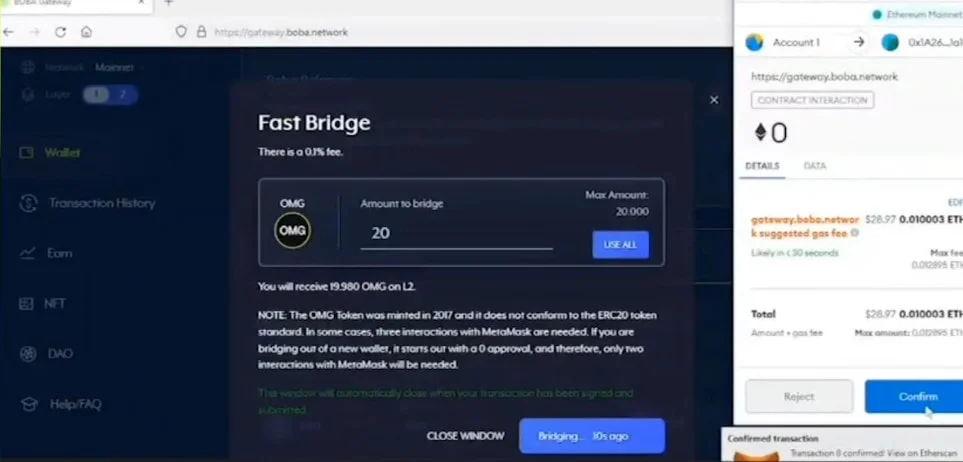
What is the Boba currency of transaction?
Currently, Ethereum has been used as a currency of transactions on the Boba network because most users have Ethereum. The developer doesn’t want first-time users to experience acquiring Boba token before they do any transactions. The user only has access to the bridge over Ethereum; however, if they have any other access, it would be great for Boba as there will be many different pools that the users can join in and farm.
What is the BOBA token used for?
The BOBA token serves two purposes. One is to join a network where there will be rolling out the boba dial. The Boba developers will invite the whole community or token holders to participate in proposing changes in the network by voting on proposals to improve Boba.
The second purpose is staking, where the Boba developers will be sharing a portion of the network profits with token holders who stick the tokens on the mobile network. The reason for doing this is to build an engaged community of boba token holders around the network since they need strong communities to attract more people to join Boba and achieve the vision, which is to gain more access to the large market with a large audience.
Where do the profits come from?
The profits come from the transactions that happen on the networks, which any transactions that the users do will need to burn some layer 2 gas. As a result, the network itself will need to pay Ethereum to store cryptographic proofs on the main chain to prove that the user has done the transactions correctly.
However, the user must reach a certain break-even point in order to earn a profit. The user must reach a minimum level of transactions that needs to happen before the network starts generating profits. For example, just like the airline or bus, if they have too few passengers, they will begin to lose money, so they must reach a certain point of passengers to generate profit.
How many transactions and profits can be made?
As for now, Boba Network can handle 54 transactions in one block. However, how much profit can be made depends on the variable since the developer will tweak the pricing structure to ensure the network is price competitive. The more volume the network processes, the more ability they can lower the cost per transaction.
The mechanism behind Boba
The developers have used optimistic roll-up as a mechanism for BOBA. It is a very modular system that lets the developer easily switch up and update different pieces of the optimistic roll-up system. Hence, the developer of BOBA can keep updating and adding more functionality to the BOBA system. Aside from that, by using optimistic roll-up, the developer can easily change the existing solidity code without affecting the major barrier and re-audit the smart contract since they want to make sure that BOBA is compatible with virtually all smart contracts.
What is optimistic rollup?
BOBA has been called “optimistic rollup” because its system gives the users the benefit of the doubt. The BOBA system has provided the users with a community fraud detector. The community fraud detectors can allow the users to compute whether the operator is honest or fraudulent by checking every single one of the BOBA states routes and transactions that they submit to L1.
Why not a centralised platform?
The system is set up in which all the funds that are on L2 are on Ethereum mainstream bridges or in volts that are positioned on a theory main chain. Everything that is going on in the L2 represents tokens and Ethereum that live on the L1. When you bridge funds on the L2, BOBA will represent those funds on the L2, and when you leave, L2 will burn them. However, the actual tokens reside on the L1 permanently, so that it gives people a little bit extra security on what would happen if BOBA went down. Aside from that BOBA is an open-source project in which the code used has been audited once and is now being reaudited for a second time.
What is the difference between all the L-2 solutions?
There are two main categories that Boba considers using, which is the Zero-Knowledge (ZK) roll-up and the Optimistic roll up. However, the developer has decided to use the Optimistic roll-up to run immediately and easily arbitrary solidity smart contracts compared to the ZK roll-up which cannot take arbitrary smart contracts and run on ZK layer 2. Aside from that, the cost for Optimistic roll-up is lesser compared to ZK roll up
Conclusion
In conclusion, people should try BOBA since many new dApps are launching and lots of farming opportunities that many robot users have enjoyed. Plus, there will be an NFT series launching, which will be a good opportunity to try BOBA.

